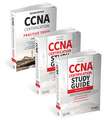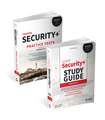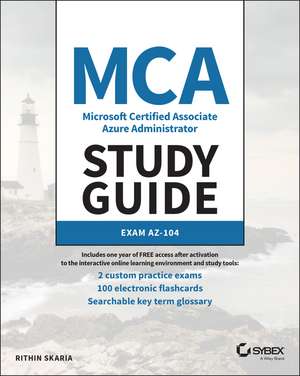MCA Microsoft Certified Associate Azure Administrator Study Guide: Exam AZ–104: Sybex Study Guide
Autor R Skariaen Limba Engleză Paperback – 29 iun 2022
Din seria Sybex Study Guide
- 20%
 Preț: 206.41 lei
Preț: 206.41 lei - 20%
 Preț: 204.48 lei
Preț: 204.48 lei -
 Preț: 416.00 lei
Preț: 416.00 lei - 20%
 Preț: 204.15 lei
Preț: 204.15 lei -
 Preț: 260.98 lei
Preț: 260.98 lei - 20%
 Preț: 272.31 lei
Preț: 272.31 lei - 20%
 Preț: 467.73 lei
Preț: 467.73 lei - 20%
 Preț: 343.55 lei
Preț: 343.55 lei - 20%
 Preț: 205.15 lei
Preț: 205.15 lei - 20%
 Preț: 289.39 lei
Preț: 289.39 lei - 20%
 Preț: 272.52 lei
Preț: 272.52 lei -
 Preț: 322.04 lei
Preț: 322.04 lei - 20%
 Preț: 304.03 lei
Preț: 304.03 lei -
 Preț: 351.33 lei
Preț: 351.33 lei -
 Preț: 404.31 lei
Preț: 404.31 lei - 20%
 Preț: 175.26 lei
Preț: 175.26 lei -
 Preț: 325.22 lei
Preț: 325.22 lei -
 Preț: 288.65 lei
Preț: 288.65 lei -
 Preț: 383.42 lei
Preț: 383.42 lei - 20%
 Preț: 399.67 lei
Preț: 399.67 lei - 8%
 Preț: 439.49 lei
Preț: 439.49 lei -
 Preț: 427.34 lei
Preț: 427.34 lei - 8%
 Preț: 365.37 lei
Preț: 365.37 lei - 8%
 Preț: 441.16 lei
Preț: 441.16 lei - 20%
 Preț: 274.58 lei
Preț: 274.58 lei -
 Preț: 322.04 lei
Preț: 322.04 lei -
 Preț: 413.10 lei
Preț: 413.10 lei - 20%
 Preț: 298.46 lei
Preț: 298.46 lei - 20%
 Preț: 274.41 lei
Preț: 274.41 lei -
 Preț: 257.90 lei
Preț: 257.90 lei - 20%
 Preț: 289.18 lei
Preț: 289.18 lei - 20%
 Preț: 309.99 lei
Preț: 309.99 lei - 20%
 Preț: 221.90 lei
Preț: 221.90 lei - 20%
 Preț: 411.29 lei
Preț: 411.29 lei - 20%
 Preț: 276.82 lei
Preț: 276.82 lei - 20%
 Preț: 278.23 lei
Preț: 278.23 lei - 20%
 Preț: 224.78 lei
Preț: 224.78 lei -
 Preț: 294.97 lei
Preț: 294.97 lei -
 Preț: 291.72 lei
Preț: 291.72 lei -
 Preț: 321.94 lei
Preț: 321.94 lei - 20%
 Preț: 281.57 lei
Preț: 281.57 lei - 20%
 Preț: 251.37 lei
Preț: 251.37 lei -
 Preț: 324.94 lei
Preț: 324.94 lei - 20%
 Preț: 308.58 lei
Preț: 308.58 lei -
 Preț: 432.33 lei
Preț: 432.33 lei -
 Preț: 407.96 lei
Preț: 407.96 lei - 20%
 Preț: 289.14 lei
Preț: 289.14 lei -
 Preț: 340.55 lei
Preț: 340.55 lei - 20%
 Preț: 280.68 lei
Preț: 280.68 lei
Preț: 326.42 lei
Nou
Puncte Express: 490
Preț estimativ în valută:
62.47€ • 64.98$ • 51.57£
62.47€ • 64.98$ • 51.57£
Carte disponibilă
Livrare economică 24 martie-07 aprilie
Livrare express 08-14 martie pentru 58.06 lei
Preluare comenzi: 021 569.72.76
Specificații
ISBN-13: 9781119705154
ISBN-10: 1119705150
Pagini: 592
Dimensiuni: 192 x 233 x 28 mm
Greutate: 0.98 kg
Editura: Sybex
Seria Sybex Study Guide
Locul publicării:Hoboken, United States
ISBN-10: 1119705150
Pagini: 592
Dimensiuni: 192 x 233 x 28 mm
Greutate: 0.98 kg
Editura: Sybex
Seria Sybex Study Guide
Locul publicării:Hoboken, United States
Notă biografică
ABOUT THE AUTHOR RITHIN SKARIA is a cloud evangelist, speaker, consultant, and a published author with an interest in cloud architecture design and optimization. With a decade of experience managing, implementing, and designing IT infrastructure solutions for public and private clouds, he is currently working with Microsoft as a Customer Engineer, focusing on Azure solutions. Rithin has over 18 certifications in different technologies such as Azure, Linux, Microsoft 365, and Kubernetes; he is also a Microsoft Certified Trainer. Rithin has been recognized has one of the engagement leads for his contributionsto the Microsoft Worldwide Open Source Community. He has presented at various events and conferences, including Microsoft Spark.
Descriere scurtă
Cuprins
Introduction xxiii Assessment Test xxx Chapter 1 Identity: Azure Active Directory 1 Chapter 2 Compliance and Cloud Governance 49 Chapter 3 Virtual Networking 109 Chapter 4 Intersite Connectivity 153 Chapter 5 Network Traffic Management 203 Chapter 6 Azure Storage 245 Chapter 7 Azure Virtual Machines 307 Chapter 8 Automation, Deployment, and Configuration of Resources 349 Chapter 9 PaaS Compute Options 387 Chapter 10 Data Protection 445 Chapter 11 Monitoring Resources 475 Appendix Answers to the Review Questions 515 Chapter 1: Identity: Azure Active Directory 516 Chapter 2: Compliance and Cloud Governance 517 Chapter 3: Virtual Networking 519 Chapter 4: Intersite Connectivity 520 Chapter 5: Network Traffic Management 521 Chapter 6: Azure Storage 522 Chapter 7: Azure Virtual Machines 524 Chapter 8: Automation, Deployment, and Configuration of Resources 526 Chapter 9: PaaS Compute Options 528 Chapter 10: Data Protection 529 Chapter 11: Monitoring Resources 530 Index 533 Table of Exercises Exercise 1.1 Viewing Users in Your Directory 9 Exercise 1.2 Creating Users in Azure AD 14 Exercise 1.3 Modifying and Deleting Users 16 Exercise 1.4 Performing Bulk Operations 20 Exercise 1.5 Viewing Groups in Azure AD 27 Exercise 1.6 Adding Security Groups to Azure AD 29 Exercise 1.7 Adding Microsoft 365 Groups in Azure AD 32 Exercise 2.1 Creating a Resource Group from the Azure Portal 61 Exercise 2.2 Listing Resource Groups from the Azure Portal 63 Exercise 2.3 Deleting Resource Groups from the Azure Portal 64 Exercise 2.3 Implementing a Custom Policy . 73 Exercise 2.4 Creating a Custom Role Using PowerShell 87 Exercise 2.5 Assigning Roles from the Azure Portal 91 Exercise 3.1 Creating Virtual Networks 114 Exercise 3.2 Creating Virtual Networks Using Azure PowerShell 116 Exercise 3.3 Creating Public IP Addresses 117 Exercise 3.4 Creating a Route Table 121 Exercise 3.5 Creating a Custom Route 122 Exercise 3.6 Associating a Routing Table to a Subnet 124 Exercise 3.7 Creating an Azure DNS Zone 130 Exercise 3.8 Adding Records to an Azure DNS Zone 132 Exercise 3.9 Creating a Private DNS Zone and Validating Resolution 134 Exercise 3.10 Creating NSG and NSG Rules 139 Exercise 4.1 Implementing Virtual Network Peering in the Azure Portal 159 Exercise 4.2 Implementing the Virtual Network to Virtual Network VPN in the Azure Portal 173 Exercise 4.3 Implementing a P2S VPN in the Azure Portal 183 Exercise 5.1 Implementing Load Balancing in Azure 215 Exercise 5.2 Implementing Azure Application Gateway 227 Exercise 6.1 Uploading Blobs 262 Exercise 6.2 Working with SAS Keys 273 Exercise 6.3 Working with AzCopy 294 Exercise 7.1 Creating a Windows Virtual Machine 316 Exercise 7.2 Connecting to a Windows VM Using RDP 321 Exercise 7.3 Connecting to a Linux VM Using a Password 325 Exercise 7.4 Connecting to Linux VM Using SSH Keys 327 Exercise 7.5 Connecting to Linux VM Using SSH Keys 329 Exercise 8.1 Composing an ARM Template 362 Exercise 9.1 Creating an App Service Plan 392 Exercise 9.2 Creating an App Service Plan 397 Exercise 9.3 Building and Running Containers in Azure 416 Exercise 9.4 Running Applications in an AKS Cluster 435 Exercise 10.1 Implementing a VM Backup 455 Exercise 11.1 Creating Alerts 486 Exercise 11.2 Ingesting Logs to the Log Analytics Workspace 497
